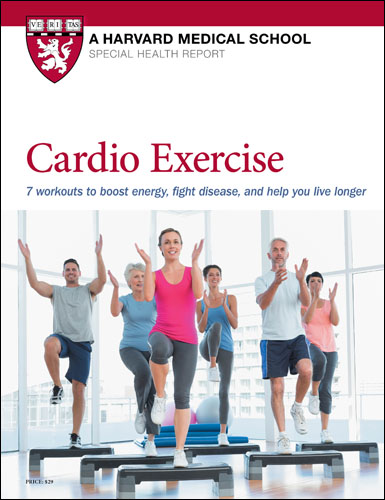Rethinking cardio exercise
Here are some alternatives for meeting weekly requirements.
- Reviewed by Howard E. LeWine, MD, Chief Medical Editor, Harvard Health Publishing; Editorial Advisory Board Member, Harvard Health Publishing

Standard exercise guidelines call for at least 150 minutes per week of moderate-intensity aerobic exercise. But many people have trouble reaching this mark.
"They either don't enjoy aerobic workouts or have physical or medical issues that make traditional cardio exercise a challenge," says Dr. Caroline Apovian, co-director of the Center for Weight Management and Wellness at Harvard-affiliated Brigham and Women's Hospital. "Then there is the additional barrier of thinking these requirements take too much time and effort. All this can intimidate people and keep them from getting their necessary exercise."
Breaking it down
The first step to overcoming these obstacles is to break down the time commitment into manageable segments. For example, 150 minutes is 2.5 hours, which comes to 30 minutes five days a week, or about 20 minutes daily. "And you don't have to do those 20 to 30 minutes all at once," says Dr. Apovian. "You can further divide into two or three 10-minute daily segments. Everyone has 10 minutes to devote to exercise."
Next, change your perception of "moderate intensity." "People automatically feel overwhelmed because it sounds difficult, but this level of exertion is not as physically demanding as people may think and is quite doable," says Dr. Apovian. (See "How to measure moderate-intensity exercise.")
How to measure moderate-intensity exerciseA simple measure of moderate-intensity exercise is the "talk test": you're at the right level if you're exercising hard enough to break a sweat but can still comfortably hold a conversation. Another approach is to use the Borg Rating of Perceived Exertion scale, which classifies exercise intensity by how you feel. Signs like higher heart rate, heavier and faster breathing, increased sweating, and tired muscles indicate higher levels of intensity. A modified Borg scale rates exertion from 1 to 10, with 1 being extremely easy and 10 being very vigorous (involving labored breathing or gasping for air). Moderately intense activities are 5 to 6 on this scale, meaning "somewhat hard" exertion with heavy breathing. |
Different kinds of aerobics
Any kind of movement that gets the heart rate up, speeds up your breathing, and makes you sweat a little counts as aerobic exercise. The best exercise is the one you enjoy. But don't assume you are limited to traditional activities like running, cycling, swimming, or tennis. There are other options that may better fit your interests, comfort level, and ability. Here are some examples.
Brisk walking. Walking at a brisk pace is a simple moderate-intensity workout. But what is "brisk"? That pace is different for everyone, but here is advice from President Harry Truman, known for his quick-paced morning walks around Independence, Mo., after he left office. He followed a pace of 120 steps a minute for 1.5 miles, a routine he learned in the Army. "You swing your arms and take deep breaths as you walk … your whole body gets a vigorous workout," he wrote.
Stair climbing. Set a timer for five to 10 minutes and go up and down stairs at a casual pace.
Treadmill. The trusty treadmill can be an excellent cardio tool, as you can adjust the incline and speed to reach the required intensity.
Marching in place. You don't need a lot of space for cardio. For instance, try marching in place. Stand with your feet together and arms at your sides. Bend your elbows and swing your arms as you lift your knees, one at a time, bringing them as high as possible with each movement. March in place for 50 steps at a steady rhythm. Rest and repeat several times.
Home work. Many household chores count as moderate-intensity exercises. Examples include mowing the lawn, raking leaves, digging and planting, washing the car, and vacuuming. "Even though these are often stop-and-go activities and may feel light, the movements can add up," says Dr. Apovian.
Weight training. Guidelines also recommend doing weight training on at least two days of the week to help build and maintain muscle mass. But this also can be a way to add in some moderate-intensity aerobics. "Doing weight training exercises in a circuit fashion, where you move from one exercise to the next with little to no rest, can elevate the heart rate enough to provide cardio benefits," says Dr. Apovian.
Different movements. "Almost any kind of movement can qualify if done with enough effort," says Dr. Apovian. "Take a dance class, go for a hike, play pickleball, or walk 18 holes of golf instead of riding a cart."
Image: © Amir Mukhtar/Getty Images
About the Author

Matthew Solan, Executive Editor, Harvard Men's Health Watch
About the Reviewer

Howard E. LeWine, MD, Chief Medical Editor, Harvard Health Publishing; Editorial Advisory Board Member, Harvard Health Publishing
Disclaimer:
As a service to our readers, Harvard Health Publishing provides access to our library of archived content. Please note the date of last review or update on all articles.
No content on this site, regardless of date, should ever be used as a substitute for direct medical advice from your doctor or other qualified clinician.
















